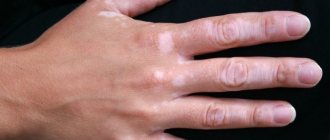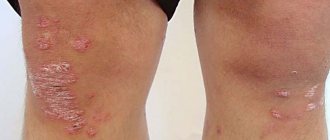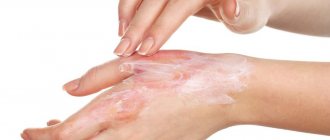Causes of Melasma Pigment Spots
Reason number 1 is ultraviolet rays. They stimulate the production of the hormone melanocrine, which activates the work of pigment cells.
Normally, a tan appears on the skin, but if there are other provoking factors, or an increased dose of UV rays, spots appear.
Clinical observations have proven that high intensity of visible light (sun, energy-saving lamps, computer and smartphone screens) increases the intensity of pigmentation in people prone to its formation.
- Pregnancy and lactation
- Taking hormonal medications, including oral contraceptives
- Endocrine system diseases
- Genetic predisposition
- Medicines or external agents with a photosensitizing effect
A study conducted on 324 women with pigment spots showed that the onset, protracted course and reappearance of pigmentation occurs when the main trigger factors are combined. Namely: pregnancy, prolonged exposure to the sun, age, taking hormonal contraceptives, genetic predisposition.
The best effect
We offer our patients procedures using the LumenisM22 IPL . The minimally invasive nature of the procedures performed on the LumenisM22 IPL guarantees a painless and fast recovery.
If a person has dark spots on the skin, you need to be especially attentive to yourself, constantly monitoring the proper care and protection of the epidermis. With the arrival of the beach season, do not forget that fair skin will always make a girl look a couple of years younger, so you should not exhaust your body under the hot rays of the sun, once again putting your skin at risk.
Pigmentation. Top articles:
- How to quickly get rid of age spots on the face?
- Care after the pigmentation removal procedure on Lumenis M22
- Photorejuvenation procedure on Lumenis M22
- Treatment of pigmentation on the face
- Laser removal of facial pigmentation
- Laser photorejuvenation
Telephone consultation is always free!
Leave your contact, we will tell you everything and offer a discount!
Send
How to lighten pigment spots with melasma
- Provide skin protection from excess exposure to ultraviolet rays and blue light. UV rays and visible light rays are the main trigger for the appearance and recurrence of pigmentation. Their use is mandatory, regardless of the time of year.
- Lightening agents that help:
- decreased division of melanocyte pigment cells
- suppression of pigment formation inside melanocytes
- destruction of formed melanosomes
Those. a full range of effects on the mechanisms of melasma.
The Latin American Academy of Pigmentary Disorders Academy-PDA has developed an algorithm for selecting therapy depending on the degree of its development:
- Mild degree - use of drugs based on Azelaic acid up to 20%
- Moderate and severe degrees - only combination therapy, including several ingredients with a brightening effect, with different mechanisms of action.
What should be included in the combination drugs, see below.
Pigmentation (hyperpigmentation) in adults and children
People often wonder why and what causes pigment spots to appear on the body. There can be quite a few reasons, most of them will be answered in our article. Heredity may be a major factor. In such cases, visual defects appear from birth or at a very young age, because information about them is embedded in the DNA.
Therefore, there is no big difference when a person decides to deal with the problem. In the most extreme situations, when this seriously spoils the appearance, and, consequently, the quality of life, treatment with modern surgical techniques, for example, laser resurfacing, is indicated. However, these are extreme measures, and alternative options can always be found. Laennec Skincare – LNC offers to transform the skin at the cellular level, prevent and completely eliminate hyperpigmentation.
What groups of ingredients are used to lighten skin?
Representatives of these groups should be sought in the compositions of combination drugs.
- Tyrosinase inhibitors – azelaic acid, arbutin, flavonoids, resveratrol .
- Destruction and reduction of melanosomes: niacinamide, soy extracts .
- Inhibition of DOPA and dopaquinone synthesis: kojic acid.
- Exfoliation of the stratum corneum: AHAs and retinoids.
- Stimulation of the conversion of melanin to leukomelanin: vitamin C, E and glabridin.
Summary : to effectively lighten pigmentation and reduce the likelihood of side effects, it is more advisable to use combined preparations containing ingredients from different groups.
Forms of hyperpigmentation
Most often, people come to our clinic with secondary hyperpigmentation (HSP) - post-traumatic or caused by exposure to ultraviolet radiation. The most common symptoms observed in patients are lentigo (25.5%), chloasma (15.3%) and post-traumatic HSV (29.5%).
Let's take a closer look at the common types of hyperpigmentation.
- Chloasma is an acquired hyperpigmentation that has an uneven dark brown tint and clear boundaries. Most often it appears on the cheeks, forehead, and less often in the chin area. The main provoking factors for the disease are genetically determined hypersensitivity of melanocytes to estrogens and ultraviolet exposure. Therefore, chloasma more often appears during pregnancy, as well as with long-term use of oral contraceptives. After discontinuation of hormonal drugs, such hyperpigmentation does not disappear on its own and can persist for a long time.
- Freckles (ephelides) are hereditary hyperpigmentation that occurs in fair-skinned people with phototype I (Celtic) or phototype II (Nordic). These are small light brown spots that cover a person's face, chest and shoulders. Their manifestations intensify in the spring and summer with increasing solar activity. With age, the number of freckles decreases on their own, but if they cause discomfort and visually age the skin, this effect can be corrected using laser technology.
- Hormonally caused melasma (melanosis) is localized on the face. This is a benign manifestation that is safe for life, but looks very unaesthetic. It is more often observed in brunettes with skin of phototype IV, which is associated with changes in the level of progesterone and estrogen in the body. The spots have an irregular shape and are usually localized in the forehead, cheeks, temples, on the upper lip and chin. Sometimes, against the background of a solid pigment spot, small rashes of a darker shade can be distinguished. Manifestations may be intensified by exposure to ultraviolet radiation.
- In the practice of a cosmetologist, post-inflammatory hyperpigmentation is often diagnosed after the resolution of inflammatory elements - the so-called post-acne.
- Secondary hyperpigmentation is quite common, which is a complication during chemical (medium) peels, laser resurfacing, dermabrasion, and occurs due to inflammation or excessive UV radiation, non-compliance with the recommended regimen after traumatic procedures. The use of certain drugs and cosmetics that have a photosensitizing effect can also cause this problem.
- Secondary hyperpigmentation (HSP) can occur as a result of a process such as photoaging of the skin with age. It is determined not only by dystrophic changes in cells, but also by the influence of the external environment, which accelerates the process of skin aging.
As a person ages, thickening and yellowing of the skin are observed, its microtexture becomes coarser, and lentiginous rashes appear on the surface - characteristic mottled pigmentation. Starting at age 30, the number of melanocytes in the skin drops by 6–8% every 10 years, but the absolute density of melanocytes in areas constantly exposed to solar radiation is twice as high as in areas protected from ultraviolet radiation. An increase in the number of melanocytes in UV-irradiated skin and a parallel disruption in the transport of melanosomes to keratinocytes contribute to the appearance of mottled pigmentation, a marker of photoaging.
The mechanism of regulation of the activity of pigment cells, as well as the synthesis of melanin, is not completely clear, but it is clearly established that ultraviolet rays serve as the trigger. According to modern authors, predisposing factors are:
- excessive ultraviolet radiation;
- hormonal disorders;
- pregnancy.
The influence of hormones on skin pigmentation
According to the free radical theory of melanogenesis, due to a lack of antioxidants, mitochondrial DNA in some areas is damaged. The skin is hormone-dependent, that is, even minor hormonal imbalances affect its condition. Many functions of the skin - mitotic activity of the epidermis, activity of pilosebaceous follicles, hair growth, etc. – are directly influenced by hormones, in particular sex hormones. Therefore, about 30% of women using combined oral contraceptives are affected by melanosis. However, stopping medication does not always lead to the disappearance of hyperpigmentation.
Hormones such as adrenocorticotropic, somatotropic and thyroid-stimulating hormones also affect melanogenesis. Scientists note that hormonally caused dyschromia is less susceptible to therapeutic effects than pigmentation resulting from exposure to sunlight or inflammatory processes.
Exfoliating treatments
One of the methods to combat hyperpigmentation is a variety of peelings:
- phytic;
- mandelic acid;
- alpha hydroxy acids;
- retinol, etc.
For photoaging, medium peeling with TCA (trichloroacetic acid) will be most effective, for post-acne - salicylic, and for melasma - pyruvic.
One of the popular methods of injection cosmetology is biorevitalization using components that lighten melanin.
Laser therapy
A modern, highly effective method of removing pigmentation is laser technology. The method of laser therapy for HSV is based on the phenomenon of photothermolysis - the ability of pigment cells to absorb the energy of a laser beam, which subsequently leads to their destruction. The laser targets the chromophore-melanin found in melanocytes, keratinocytes or macrophages.
According to scientific studies, in more than 45% of patients, the manifestations of IGP disappeared after laser therapy, and in 35% of cases, lightening of the spots was noted.
Although in most cases the effectiveness of laser therapy for VGP is quite high and 1–3 sessions are enough to completely remove spots, constant exposure to UV rays on the facial skin leads to recurrence of VGP 3–4 years after successful treatment. Therefore, the therapeutic complex includes:
- daily use of medications or medicinal cosmeceuticals with a whitening effect for a long time;
- regular use of photoprotective products, even on a cloudy city day;
- professional manipulations aimed at enhancing desquamation (exfoliation) of the epidermis and destruction of melanin-containing cells.
A universal method for treating skin hyperpigmentation has not yet been developed, but over the long history of research and treatment of pigmentation disorders, experience has been accumulated in the use of a variety of correction methods, including a range of remedies from external applications and ointments to high-tech invasive procedures using surgical methods of dermabrasion and high-intensity laser radiation.
Our clinic’s specialists are proficient in various methods for removing skin hyperpigmentation and will help you choose a set of drugs and procedures that are most suitable for the skin type and individual characteristics of each patient.









